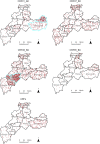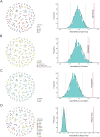Using molecular network analysis to understand current HIV-1 transmission characteristics in an inland area of Yunnan, China
- PMID: 37462024
- PMCID: PMC10540185
- DOI: 10.1017/S0950268823001140
Using molecular network analysis to understand current HIV-1 transmission characteristics in an inland area of Yunnan, China
Abstract
HIV-1 molecular surveillance provides a new approach to explore transmission risks and targeted interventions. From January to June 2021, 663 newly reported HIV-1 cases were recruited in Zhaotong City, Yunnan Province, China. The distribution characteristics of HIV-1 subtypes and HIV-1 molecular network were analysed. Of 542 successfully subtyped samples, 12 HIV-1 strains were identified. The main strains were CRF08_BC (47.0%, 255/542), CRF01_AE (17.0%, 92/542), CRF07_BC (17.0%, 92/542), URFs (8.7%, 47/542), and CRF85_BC (6.5%, 35/542). CRF08_BC was commonly detected among Zhaotong natives, illiterates, and non-farmers and was mostly detected in Zhaoyang County. CRF01_AE was frequently detected among married and homosexual individuals and mostly detected in Weixin and Zhenxiong counties. Among the 516 pol sequences, 187 (36.2%) were clustered. Zhaotong natives, individuals aged ≥60 years, and illiterate individuals were more likely to be found in the network. Assortativity analysis showed that individuals were more likely to be genetically associated when stratified by age, education level, occupation, and reporting area. The genetic diversity of HIV-1 reflects the complexity of local HIV epidemics. Molecular network analyses revealed the subpopulations to focus on and the characteristics of the risk networks. The results will help optimise local prevention and control strategies.
Keywords: HIV-1; assortativity; molecular network; spatial analysis.
Conflict of interest statement
The authors declare no conflict of interest.
Figures



Similar articles
-
Spatial clusters of HIV-1 genotypes in a recently infected population in Yunnan, China.BMC Infect Dis. 2019 Jul 29;19(1):669. doi: 10.1186/s12879-019-4276-9. BMC Infect Dis. 2019. PMID: 31357947 Free PMC article.
-
Using molecular network analysis to explore the characteristics of HIV-1 transmission in a China-Myanmar border area.PLoS One. 2022 May 6;17(5):e0268143. doi: 10.1371/journal.pone.0268143. eCollection 2022. PLoS One. 2022. PMID: 35522692 Free PMC article.
-
HIV-1 genetic characteristics and transmitted drug resistance among men who have sex with men in Kunming, China.PLoS One. 2014 Jan 29;9(1):e87033. doi: 10.1371/journal.pone.0087033. eCollection 2014. PLoS One. 2014. PMID: 24489829 Free PMC article.
-
HIV-1 Molecular Networks and Pretreatment Drug Resistance at the Frontier of Yunnan Province, China.AIDS Res Hum Retroviruses. 2024 Dec;40(12):701-712. doi: 10.1089/AID.2023.0124. Epub 2024 Jul 16. AIDS Res Hum Retroviruses. 2024. PMID: 38959124
-
The changing HIV-1 genetic characteristics and transmitted drug resistance among recently infected population in Yunnan, China.Epidemiol Infect. 2018 Apr;146(6):775-781. doi: 10.1017/S0950268818000389. Epub 2018 Mar 14. Epidemiol Infect. 2018. PMID: 29534773 Free PMC article.
Cited by
-
Exploring Dynamic Changes in HIV-1 Molecular Transmission Networks and Key Influencing Factors: Cross-Sectional Study.JMIR Public Health Surveill. 2024 May 29;10:e56593. doi: 10.2196/56593. JMIR Public Health Surveill. 2024. PMID: 38810253 Free PMC article.
-
Distinguishable topology of the task-evoked functional genome networks in HIV-1 reservoirs.iScience. 2024 Oct 21;27(11):111222. doi: 10.1016/j.isci.2024.111222. eCollection 2024 Nov 15. iScience. 2024. PMID: 39559761 Free PMC article.
-
Phylogenetic analysis and transmission networks highlight the role of older adults in the transmission of HIV-1 in northern Zhejiang, China.Virol J. 2025 Mar 15;22(1):75. doi: 10.1186/s12985-025-02681-2. Virol J. 2025. PMID: 40089756 Free PMC article.
-
Genetic diversity of HIV in Yunnan, China: the role of second-generation recombination involving circulating and unique recombinant forms.Virol J. 2025 Jul 14;22(1):240. doi: 10.1186/s12985-025-02863-y. Virol J. 2025. PMID: 40660300 Free PMC article.
-
Characterizing HIV-1 transmission by genetic cluster analysis among newly diagnosed patients in the China-Myanmar border region from 2020 to 2023.Emerg Microbes Infect. 2024 Dec;13(1):2409319. doi: 10.1080/22221751.2024.2409319. Epub 2024 Sep 30. Emerg Microbes Infect. 2024. PMID: 39315943 Free PMC article.
References
-
- Hemelaar J (2012) The origin and diversity of the HIV-1 pandemic. Trends in Molecular Medicine 18(3), 182–192. - PubMed
-
- UNAIDS. Executive Summary-In Danger: UNAIDS Global AIDS Update 2022. Available at https://www.unaids.org/en/resources/documents/2022/in-danger-global-aids... (accessed 21 December 2022).
-
- Hemelaar J, Elangovan R, Yun J, Dickson-Tetteh L, Fleminger I, Kirtley S, Williams B, Gouws-Williams E and Ghys PD (2019) Global and regional molecular epidemiology of HIV-1, 1990–2015: A systematic review, global survey, and trend analysis. Infectious Diseases 19(2), 143–155. - PubMed
Publication types
MeSH terms
LinkOut - more resources
Full Text Sources
Medical
Molecular Biology Databases

